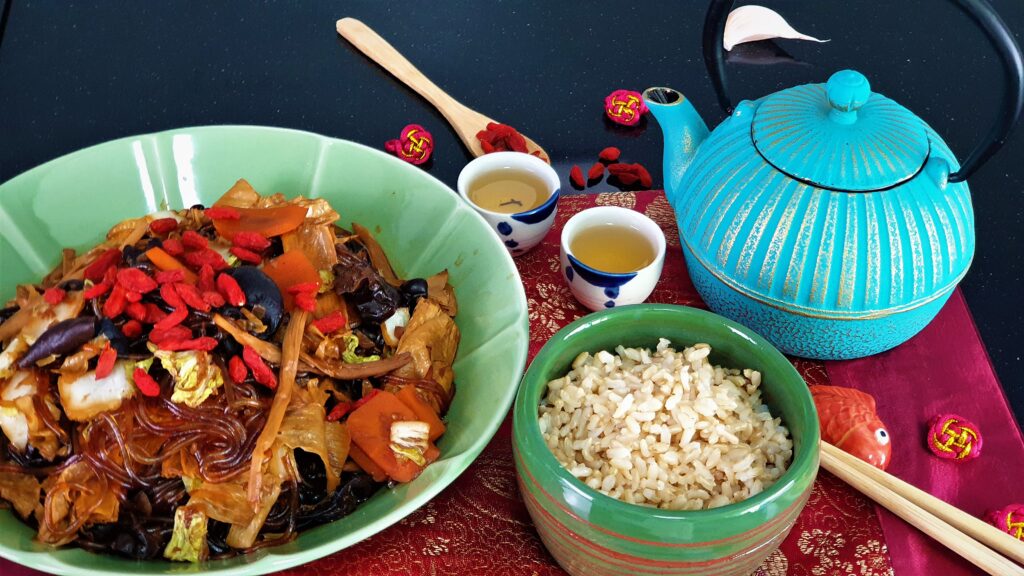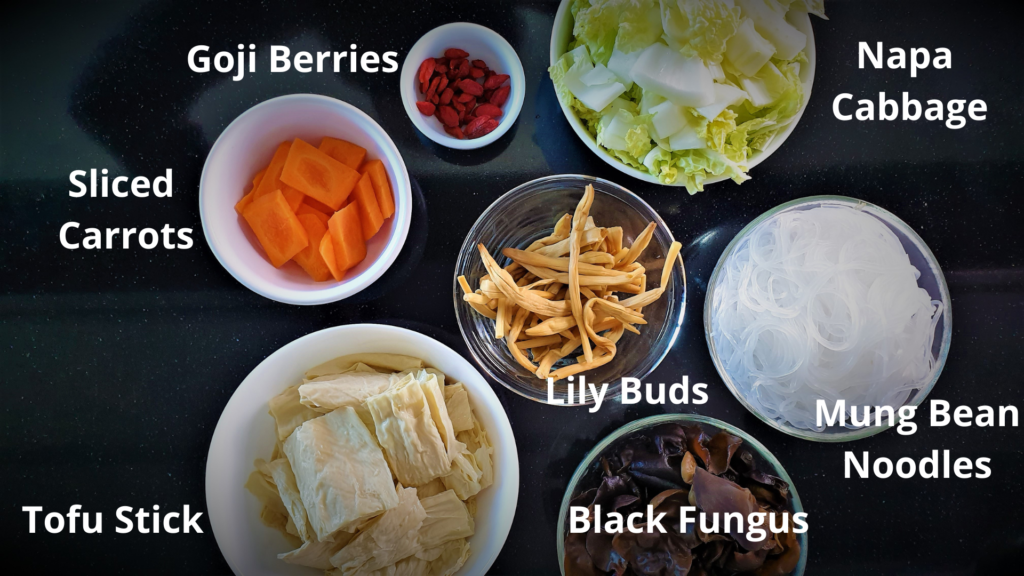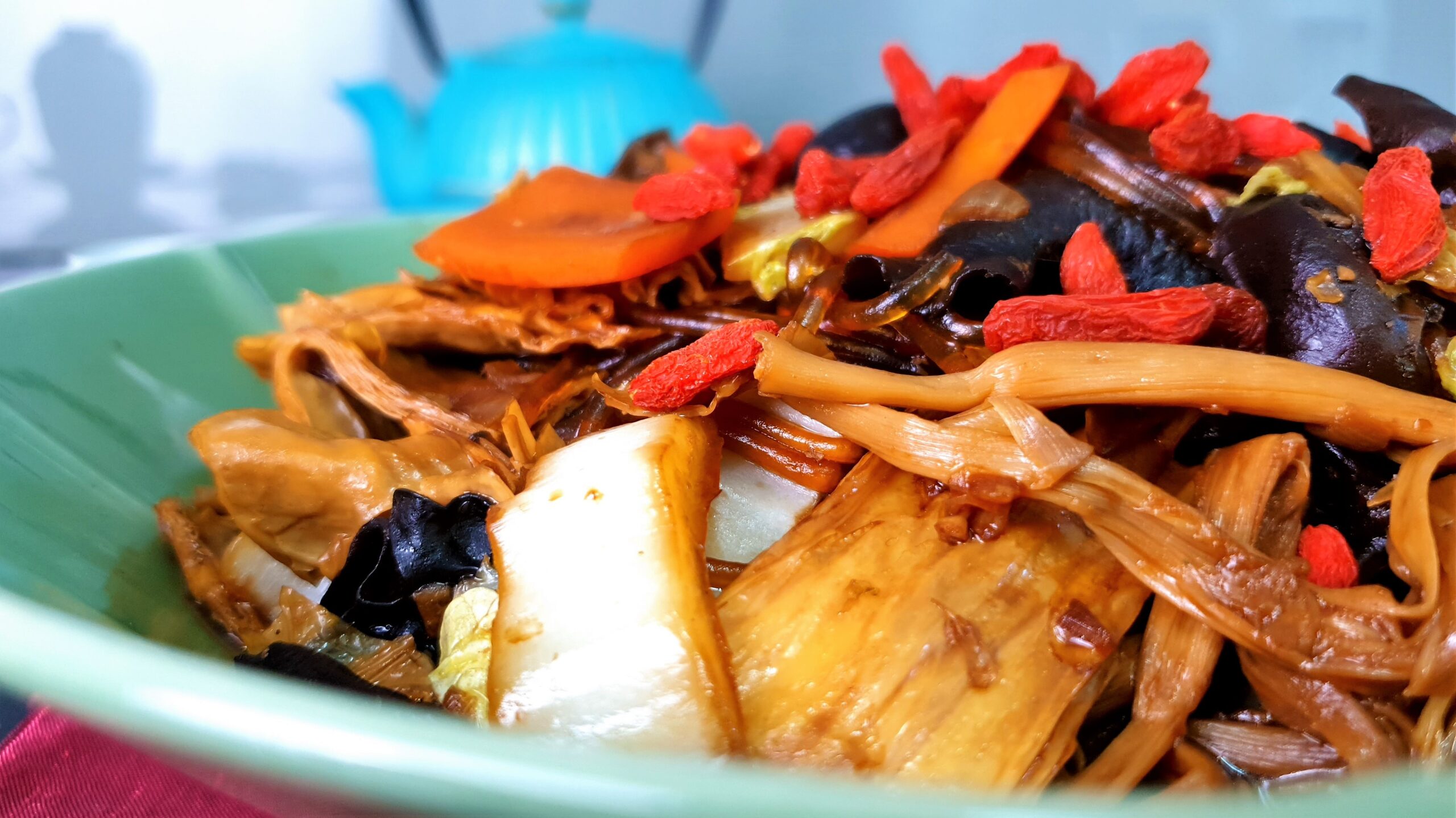Kong Xi Fa Chai! Happy Chinese New year to everyone! Healthy Asian Cuisine have a healthy Vegetarian Stir Fry recipe for you to celebrate this “Tiger” year! Famously known as Buddha’s Delight, this New Year’s day dish was created by the Buddhists. In the Buddhist tradition, no animal or fish should be killed on the first day of the lunar year. This vegetarian dish is cooked in a delicious and easy-to-prepare sauce to produce a hearty, filling and satisfying dish. Serve over rice or grains for a complete meal.

Makes: 6-8 servings Preparation Time: 30 minutes Cooking Time: 10 minutes
Course: Chinese New Year, Main Course, Side Dish, Stir-fry
Cuisine: Asian, Chinese, Malaysian
Author: Healthy Asian Cuisine
Ingredients
- 3 dried tofu sticks, about 60g
- 50g/1.7oz mung bean noodles (cellophane or glass noodles)
- 15g/1oz dried lily buds
- 15g/0.5oz dried black fungus (wood ear fungus)
- 150g/5oz Napa cabbage (Chinese cabbage)
- 1 small carrot
- 2-3 garlic cloves
- 1 long Jersey long shallot (3 small round shallots)
- 1 cup low sodium vegetable stock
- 1 tablespoon miso paste
- Salt to taste

For the Sauce
- 2 tablespoons low sodium light soya sauce or tamari
- 2 tablespoons dark soya sauce
- 2 tablespoons Shao Hsing wine or dry sherry
- 1 teaspoon sesame seed oil
- ½ to 1 tablespoon coconut sugar, according to taste
- ¼ – ½ teaspoon white pepper, to taste
To Garnish
- 1 tablespoon goji berries
Method
Step 1: Preparing Your Ingredients (Mise En Place)
- To soak the dried tofu stick, break the stick into 1 to 2 inches pieces, place them into a big bowl then add 500ml to 750ml (2-3 cups) hot water and soak for 30 minutes until it is softened.
- Soak the dry black fungus with 500ml (2 cups) of boiling water for 20-30 minutes until it is expanded and puffed up.
- Place dried lily buds in a bowl and cover with 500ml/2 cups of hot water. Leave the buds to sit for at least 30 minutes or up to 2 hours, until they have softened. Drain and rinse. Finally, remove the hard stem or knob by using a pair of scissors or knife to cut off about 1 cm/1/4 inch at the bottom of the bud.
- In a large bowl, soak the glass noodles with 500ml/2 cups of hot water until pliable, about 10-15 minutes. Drain well and shake off any excess water then set aside.
- To prepare for the rest of the ingredients, first, start with the carrot. Slice a few millimetres from the side of the carrot in lengthways to turn it into a rectangular shape. Then slice the rectangular carrot into 2-3 millimetres thick bias.
- Next, cut the Napa cabbage into bite-size pieces.
- Finely chop the shallots and crush the garlic with a garlic press.
- Place vegetable stock in a bowl then dissolve 1 tablespoon of miso paste in the stock.
Step 2: Preparing the Sauce
- To prepare the stir-fry sauce, mix the soya sauce or tamari, dark soya sauce, Shao Hsing wine, coconut sugar, sesame seed oil, and white pepper, making sure to dissolve all of the coconut sugar and white pepper. Set aside.
Step 3: Cooking the Vegetarian Dish
- Heat your wok or a skillet over medium-high heat, then add the oil and shallots. Stir frequently to let the shallots caramelize for about 30 seconds to a minute without letting it burn. Next, throw in the crushed garlic, stir-fry for 10 seconds then add the soaked tofu stick, followed by the black fungus, the soaked lily flowers and sliced carrot. Stir fry for 1 minute. Before adding the vegetable stock with miso paste, stir the mixture again to bring up the dissolved paste that sank at the bottom. At this moment, stir to mix all ingredients to combine with the stock and bring it to a boil. Once boil, lower the heat to simmer then cover the skillet to let cook for 6 minutes, stirring occasionally.
- Once it has cooked for 6 minutes, uncover the skillet to add the chopped Napa cabbage. Stir-fry the Napa cabbage for about a minute then add the sauce. Turn the heat back up to high and continue to stir-fry for another minute. Make a well in the middle of the skillet, add the mung bean noodles. Keep stirring to mix the noodles with the sauce. The noodles are considered cooked when they become transparent and soak up most of the liquids.
- Before dishing out, taste the dish, add a little bit of salt or sugar if needed. Finally, garnish the dish with goji berries. Serve immediately over steam rice or grains for a complete meal.
| Notes: Miso paste – Miso pastes with fermented soya beans and is a staple of Japanese cooking. Its ultra-savoury, umami flavour gives all sorts of dishes a lovely depth. It’s widely sold in Chinese, Japanese and Korean grocery stores. Most supermarkets will display this product on the Japanese food or Korean food aisle. Dried Ingredients – All the dried ingredients can be prepared in advance by soaking them in cold water overnight. Black fungus and Lily buds – Make sure you rinse the rehydrated black fungus and lily buds a couple of times because they often contain dust and sand in them. Shoa Hsing Wine – Shoa Hsing wine are widely sold in an Asian grocery store. If you can’t find Shoa Hsing wine, substitute it with dry sherry or Japanese sake. |
DID YOU MAKE THIS RECIPE?
Tag @healthyasiancuisine on Instagram and hashtag it #healthyasiancuisine

